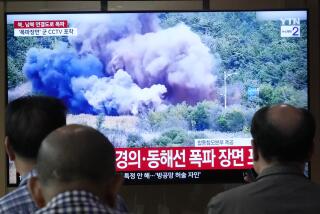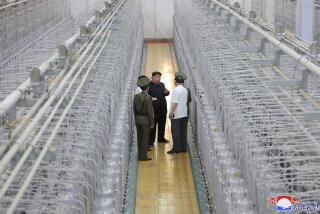North Korea looks down, feels secure
- Share via
BEIJING — In a nondescript neighborhood of Beijing near the Temple of Heaven, behind a seemingly normal doorway, two flights of stairs reveal a 62-mile complex of tunnels built in the 1970s as China braced for Soviet and U.S. attack.
“Many Chinese tourists ask us if Americans will bomb us in the future,” guide Shao Cen said, standing next to a poster that read “American Invaders Will Fail” as water dripped from the flaking plaster overhead.
Situated along the 8-foot-high tunnels are the remains of hospitals, reading and conference rooms, warehouses and arsenals, part of a network that once linked Beijing’s airport, Tiananmen Square and the government ministries.
News that North Korea had conducted its first nuclear test in a tunnel 60 miles from the Chinese border brought the memories of those invasion fears flooding back -- and kindled a kind of empathy for China’s controversial neighbor.
“The success of the Chinese government’s propaganda campaign turned us all into Spartan soldiers eager for war so we could become communist heroes,” said Ni Lexiong, a military analyst with the Shanghai Institute of Politics and Law who helped build an underground network in that city. “I believe the North Koreans are feeling exactly the same today. Nor can I imagine them giving up on a war effort after a few setbacks. I believe their mind is determined and fixed.”
North Korea certainly had several reasons to conduct the Oct. 9 test underground: The subterranean endeavor provided an element of surprise by allowing the government in Pyongyang to time the blast for maximum political impact. It hid many of the preparations from prying U.S. satellites. And, assuming that adherence to international agreements matters to North Korea, it allowed the regime to comply with the 1963 nuclear test ban treaty, which forbids above-ground testing.
But the North’s love affair with tunnels goes far deeper than the shaft bored into the 1,188-foot Hwadaeri mountain that has become the focus of global attention. Tunnels hold deep psychological comfort for the North Koreans, analysts say, providing a sense of safety from above-ground threats.
“North Korea’s extensive tunnel network makes them much braver in times of crisis like this,” said Kim Tae-woo, a senior fellow with the Korea Institute for Defense Analyses. “It’s a key part of the political effect their authorities aim at, the belief that the nation can be defended.”
According to South Korean propagandists, North Korea’s founder Kim Il Sung once said, “One good tunnel is worth more than an atomic bomb.”
“It’s an effective and easy way to deal with countries like the U.S. and Japan with advanced technology,” Jin Linbo, Asia-Pacific director with the China Institute of International Studies in Beijing, said of the North’s tunnel vision, which had its genesis in the Korean War half a century ago. “For a poor country with mountains, the only way is to take advantage of this land advantage.”
Each subsequent war involving archenemy America that North Koreans have watched on their fuzzy TV sets -- from Vietnam and the removal of President Slobodan Milosevic in Yugoslavia to the two Iraq wars -- has only underscored the strength of U.S. airpower and the need to retreat farther into the darkness of the North’s estimated 8,000 to 18,000 tunnels.
The nation’s obsession can be seen in the 330-foot depth of the Pyongyang subway, the fear of imminent U.S. attack reinforced by constant propaganda and the location deep underground of museums related to the military or leadership.
“This has more security in case of bombing,” guide Paek Hye Sim told foreign visitors in one museum north of the capital last fall.
A 33-page “Detailed Wartime Guidelines” manual from North Korea that surfaced in South Korea early last year orders all government offices and military units to retreat underground with weapons and food within 24 hours of a war breaking out. South Korean analysts said its timing reflected the Pyongyang regime’s fear that it was Washington’s next target after Iraq.
Everyone should also bring their portraits, plaster busts and bronze statues of leader Kim Jong Il and his parents, it adds, so that these might be protected in a special room.
The discovery between 1974 and 1990 of at least four major tunnel systems running from North Korea across the demilitarized zone and into the South rattled South Korean nerves. Some were discovered after patrolling soldiers noticed smoke, heard voices and felt explosions underground, others after intelligence was gleaned from defectors.
Experts estimated that the cross-border shafts, some with rail lines, platforms for heavy equipment and communication cables buried hundreds of feet below ground, would allow 30,000 North Korean troops to infiltrate in an hour.
“It was eerie,” said David M. Finkelstein, director of Project Asia at the Alexandria, Va., nonprofit research center CNA Corp. and a former Army officer posted at the Panmunjom truce village in the early 1980s. “I was absolutely amazed at how wide and high the tunnel I visited was.”
There haven’t been any major discoveries in recent years, leading some to conclude the North has focused its tunnel-building exclusively inward.
Others aren’t so sure, however, and accuse the South of hiding such finds in keeping with its accommodating “sunshine policy” toward its mercurial northern neighbor.
The fear that Northern soldiers might one day pop out of a Seoul or Incheon sewer has spurred on a small group of avid South Korean tunnel hunters who comb the country, poking microphones, cameras and lasers into the ground in search of the North’s mole holes.
“Kim Jong Il’s regime can only collapse, but even a rat will charge if driven into a corner,” said Kim Han-sik, a pastor who heads a prominent tunnel-hunting group. “We don’t know when the country could be taken by the North Koreans.”
Back in the Beijing tunnel network, guides sporting Chairman Mao pins and camouflage outfits over their designer shoes steer visitors through a small part of the maze deemed safe to navigate.
In a sign of just how far China has drifted from the days of invasion obsession, however, a large underground military planning hall has been turned into a well-stocked silk and souvenir market.
“Business is good,” Shao said. “We give you very good price for the quality.”
More to Read
Sign up for Essential California
The most important California stories and recommendations in your inbox every morning.
You may occasionally receive promotional content from the Los Angeles Times.













